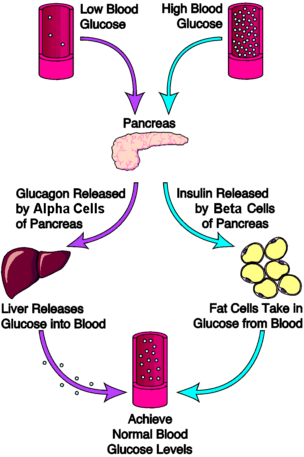 Insulin and glucagon are like our yin and yang in regards to blood sugar levels. Both are produced by the pancreatic islets, the endocrine portion of the pancreas.
Insulin and glucagon are like our yin and yang in regards to blood sugar levels. Both are produced by the pancreatic islets, the endocrine portion of the pancreas.
- Insulin is made by the beta cells in the pancreatic islets.
- Glucagon is made by the alpha cells in the pancreatic islets.
- Mnemonic: I remember this by remembering a vowel goes with a consonant, so Insulin starts with a vowel (i) and is matched up with Beta cells, which starts with a consonant (b). Glucagon starts with a consonant (g) and matches up with Alpha, which starts with a vowel (a).
Insulin and glucagon are both protein hormones which means if you had to give either one to a patient it would have to be done through an injection, as opposed to steroid hormones which are lipids and can be taken orally.
Insulin causes sugars in the blood stream to be transported into the cells, decreasing the blood sugar level. This sugar is usually used for creating ATP. In the liver, however, the glucose molecules join together to form a polysaccharide called glycogen. This process is called glycogenesis which literally means “to produce glycogen.”
Glucagon causes the breakdown of glycogen from the liver to release glucose into the blood stream, thus raising blood sugar levels. Interestingly enough, muscle glycogen can only be used by the muscle while liver glycogen can be re-released into the blood stream to be used by the muscles as well. This process is called glycogenolysis which literally means the breakdown (-lysis) of glycogen.
Fundamentally, insulin and glucagon are very important for keeping this balance. If you eat a bunch of sugar, insulin is going to be released to get rid of all the sugar in the blood stream. If you haven’t eaten anything for several hours, your body prevents your blood sugar from getting too low by releasing glucagon to help release glucose back into the blood stream. This process is known as homeostasis. This is what our body normally does to keep the blood sugar level constant, the same way your temperature stays the same no matter what the temperature is outside.
Now that we have learned about this, let’s go back to understanding cell respiration.
Cellular respiration
- Anabolic and Catabolic Reactions
- Intro to Cellular Respiration: The Production of ATP
- How Glucose Levels are Regulated in the Blood Stream
- Cell Respiration Part 1: Anaerobic Respiration (Glycolysis and Fermentation)
- Cell Respiration Part 2: Aerobic Respiration (Transition Reaction & Kreb’s Citric Acid Cycle)
- Cell Respiration Part 3: Aerobic Respiration (Electron Transport System)
- The Catabolism of Fats and Proteins for Energy
- The Catabolism of Nucleic Acids
- Oxygen Debt








